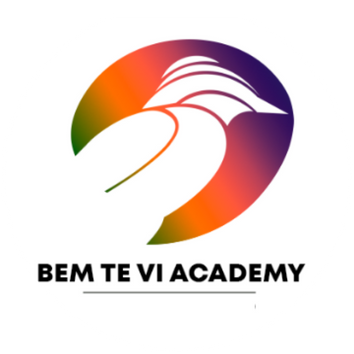
Sobre o curso
Bem-vinde à sua jornada com a Bem-Te-Vi.
O primeiro passo já foi dado — e ele é mais poderoso do que parece. Ao se permitir aprender inglês conosco, você também se abre para algo ainda mais profundo: um reencontro com sua voz, com sua coragem e com a pessoa que você está se tornando.
Aqui, aprender inglês vai muito além de decorar regras. É sobre se expressar com verdade. É sobre destravar a sua história, ressignificar medos antigos e criar uma nova relação com o aprender.
A experiência Bem-Te-Vi é viva, sensorial, humana.
Você terá acesso a uma plataforma moderna e intuitiva (LMS Avançado), desenhada para acompanhar o seu ritmo e despertar sua curiosidade com conteúdos interativos que respondem às suas escolhas, seus erros e suas conquistas em tempo real.
Com feedback imediato e avaliação formativa, você poderá se autorregular, ajustar a rota e celebrar cada passo com consciência. A jornada é sua — e ela será respeitada.
A gamificação adaptativa transforma o estudo em uma experiência leve e envolvente: badges, pontos e níveis que não apenas motivam, mas mostram o quanto você está crescendo.
E se prepare para algo único: realidade aumentada e experiências multissensoriais que colocam o inglês na pele, nos olhos, nos ouvidos e no coração. Você vai sentir o idioma de um jeito novo — mais vivo, mais presente.
Com nossos chatbots com IA, você poderá praticar conversação em tempo real, recebendo feedback fonético e gramatical com segurança e autonomia.
E nunca estará só. Nossos ambientes colaborativos e comunidades virtuais são espaços de troca, partilha e pertencimento — porque crescer ao lado de outros torna tudo mais possível.
Integramos ferramentas de bem-estar ao longo da jornada: Eneagrama, respiração consciente, mindfulness, EFT, posturas físicas e PNL. Cada prática terapêutica se conecta com um objetivo linguístico — para que corpo, mente e voz caminhem juntos.
Com microlearning sessions e exercícios emocionais guiados em áudio e vídeo, você poderá acessar conteúdos curtos, profundos e transformadores, ideais para a sua rotina — e para seu momento emocional.
Tudo isso dentro de ambientes seguros e acolhedores, onde errar é bem-vindo, o silêncio é respeitado e a expressão é incentivada com cuidado e verdade.
Nossas aulas são dinâmicas, conversacionais e profundamente conectadas com contextos reais do mercado profissional — porque seu inglês precisa servir à sua vida, aos seus sonhos e à sua missão no mundo.
Seja muito bem-vinde.
Estamos com você, passo a passo, respiração por respiração.
Com carinho,
Time Bem-Te-Vi
Conteúdo do curso
Trilha de conhecimento: Inglês – Curso B1
-
Seja bem vind@: Informações importantes
-
Comece aqui
-
Trilha de desenvolvimento emocional
-
Unit 1: Moments in Time: Present Perfect vs. Present Perfect Continuous
-
Unit 2: Talking About Future Actions – Future Continuous and Future Perfect
-
Unit 3: Modal Verbs for Deduction and Speculation (Must, Might, Could)
-
Unit 4: “Telling Stories: Narrative Tenses”
-
Unit 5: Passive Voice in Different Tenses
-
Unit 6: Relative Clauses (Defining and Non-defining)
-
Conexão com o corpo e relaxamento para uma melhor comunicação
-
Conexão com o corpo e relaxamento para uma melhor comunicação parte 2
-
Unit 7: Reported Speech (Statements, Questions, Commands)
-
Unit 8: Gerunds and Infinitives; Reflexive and Emphatic Pronouns
-
Unit 9: Phrasal Verbs and Prepositional Phrases
-
Unit 10: Quantifiers and Determiners (Some, Any, No, None, Every, Each)
-
Unit 11: Adjectives and Adverbs (Intensifiers, Gradable, and Non-Gradable Adjectives)
-
Unit 12: Conditional Clauses (Zero, First, Second, Third)
-
Unit 13: Comparison Structures (As…as, So…that, Such…that, Enough to)
-
Unit 14: Expressions of Quantity (A Few, Few, A Little, Little, Plenty of)
-
Meditação como acalmar a mente
-
Unit 15: Hypothetical Situations and Wishes
-
Unit 16: Discourse Markers and Connectors
-
Unit 17: Advanced Vocabulary Topics – Collocations and Idiomatic Expressions
-
Unit 18: Advanced Modal Verbs (Shall, Ought to, Needn’t)
-
Unit 19: Formal and Informal English
-
Unit 20: Comprehensive Review and Mastery Test
-
Playfunness
-
Playfunness parte 2
Classificações e revisões de estudantes


